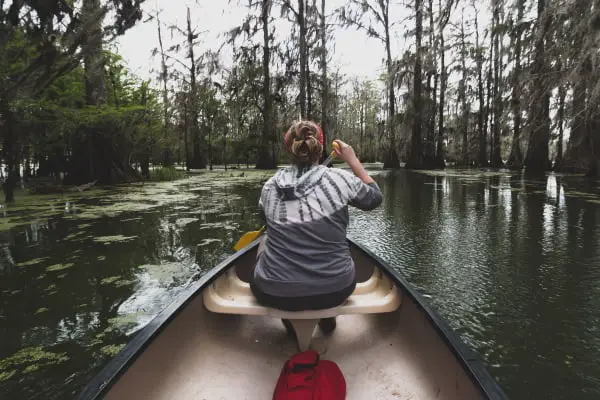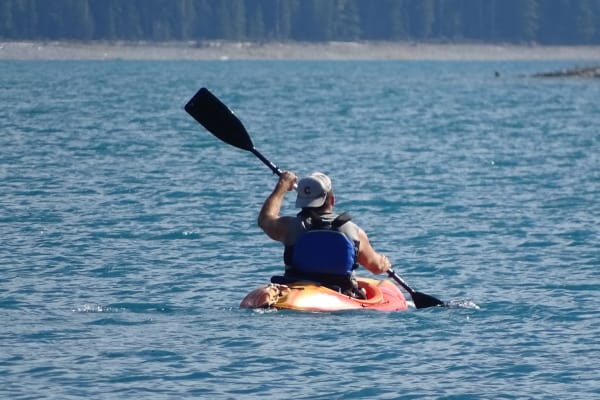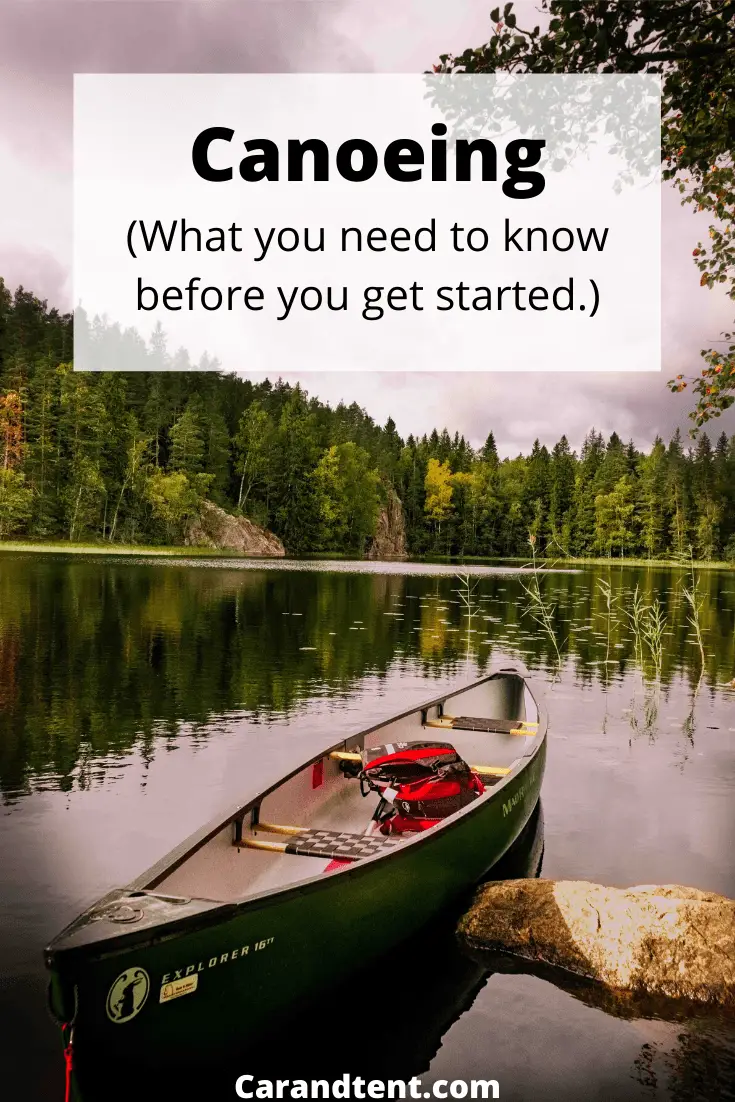
Wondering how to get started canoeing? If you’ve never been on a canoe before it might seem a bit confusing or even dangerous but you shouldn’t let that stop you.
Canoeing is a lot of fun and it isn’t as hard as you might think. It doesn’t have to be dangerous either.
In this post, I’ll teach you how to get started canoeing so you can have as much fun on a canoe as I do.
Table of Contents
What to Know Before You Get in A Canoe
Canoeing is easy but there are a few thoughts you ought to keep in mind before getting on board one. But before we get into them, you need to make sure what you’re actually looking to do is to go on a canoe. The reason I say this is because Google seems to think kayaking and canoeing are the same, but they aren’t.
Is It A Canoe or a Kayak
A canoe and a kayak are actually quite different. Canoes are meant to be paddled differently than kayaks are. They are also shaped a bit differently which makes them less maneuverable but more stable on the water.
For this reason, canoes are usually easier to start with and beginners tend to prefer canoes over kayaks. This is especially true for canoes and kayaks that hold more than one person.
The quickest way to find out whether or not you’re looking at a canoe or a kayak is to look at the paddle. A canoe will have a paddle with a single blade while a kayak will have a paddle with blades on either side. This makes paddling a kayak much quicker but it also requires a little more strength and skill.
The picture at the top of the page was a picture of a canoe. Below is a picture of a kayak. Take a moment to look at how much different the paddle is and how much lower the kayak is to the water. You can probably tell just by looking at it that it is faster than the canoe above.

For a more detailed look at canoeing vs kayaking, take a look at my post titled, “Canoeing Vs Kayaking“. Once you’ve determined that you want to start canoeing, come back here and continue through the post.
Canoe Sizing
Canoes come in specific lengths, widths, and depths. For beginners, the main thing to know is that wider canoes are more stable than more narrow canoes.
A canoe’s length will usually vary based on how many people the canoe is supposed to hold. Most canoes found at recreational rental places are two-person canoes but you can find one person canoes and three or four-person canoes as well.
The depth of a canoe will usually be determined by the type of canoe you’re dealing with. A canoe that is intended for rough waters will usually be deeper than a canoe built for still waters. As a beginner, your first experience with a canoe will most likely be on still or slow-moving waters.
How to Paddle a Canoe
Paddling a canoe isn’t very technical and it doesn’t require much strength either. What you’ll do is you’ll place one hand at the top of the paddle and you’ll place the other hand towards the center of the paddle. The paddle will go into the water on the side that your lower hand is on.
The Basic Forward Stroke
Place the paddle into the water in front of you and pull it back. Lift it out of the water and repeat once more.
When you want to go to the right, put your paddle in on the right. When you want to go to the left, put your paddle in on the left. If you paddle from back to front, so that you can move in reverse, you’ll reverse these instructions.
Here is a quick video that demonstrates the basic forward stroke.
The J Stroke
The J stroke is slightly more technical than the standard forward stroke but it’ll help keep your canoe centered and moving in a straight line as you paddle. This stroke starts off just like the basic stroke.
The difference comes in the center of the stroke. When you get to the center of your stroke, turn the blade of the paddle inward so that the blade turns towards the boat while continuing the stroke.
Here is a quick video demonstrating the J stroke.
Canoe Clothing
Canoeing usually doesn’t get a person as wet as kayaking does. This being said, I’d recommend you at least wear sandals or water shoes. Water can and does get in the bottom of canoes and it’s nice not to have to worry about your shoes getting wet when it does.
To be more comfortable, you might also want to consider wearing loose-fitting clothing that dries quickly. The loose fit will make you more comfortable as you paddle and the quick-drying material will ensure that even if you do get wet, you won’t stay wet.
What to Bring on Your Canoe
There are just a few items that you must-have when getting on a canoe. The first is your paddle. Without your paddle, you won’t be able to get very far. I also like to bring a backup paddle when possible but in most cases, this won’t be necessary.
The next item you’ll want to make sure that you have is a life preserver. Get a life preserver that’s designed for canoers. An old emergency life jacket will not give you the proper freedom of movement you need to easily manage your canoe. For white-water rapids, you’ll need a helmet as well as some other emergency gear but as a beginner, you won’t have to worry about any of this.
My next piece of advice is to bring a bottle of water with you. Canoeing isn’t hard but you’re bound to work up a sweat, especially if you’re out on the open water and without protection from the sun.
This leads me to my next two things to bring onto the canoe. Bring your sunglasses and your sunscreen. A day of canoeing can quickly be overshadowed by an evening of tending to a bad sunburn.
Where to Get a Canoe
I wouldn’t bother with buying a canoe right away. Instead, go to a lake or slow-moving river that has canoes for rent alongside it. The rental shop will rent you a lifejacket and give you a paddle and they may even give you some pointers on using the canoe.
After you’ve done this, I’d suggest you go and rent a kayak as well. Kayaking is similar but it’s different enough that you might find you like one better than the other. Only after trying out both canoeing and kayaking would I recommend you consider buying one.
Once you’ve decided to buy one, you can pretty much find them everywhere. Craigslist always has used ones for sale and you can buy new ones at specialty stores like Bass Pro Shops, Gander Mountain, and even REI. You can also find them at big box stores like Walmart and KMART as well. Shop around and consider buying off-season and you’re sure to get a good deal.
Where to Go Canoeing
One of the best places to find canoe rentals is in state parks. State parks offer canoe rentals at reasonable prices and the lakes are usually full of people who can help you out if you get into trouble.
If you don’t have any state parks nearby, check out local parks and even theme parks. There are probably more places to rent canoes near you than you ever imagined.
After you’ve purchased your own canoe, you can branch out and try different lakes and rivers that you find interesting. Just be sure to do your research on any flowing bodies of water that you’re considering canoeing on. Sometimes a seemingly calm river can quickly become fast or dangerous to be on so it’s important you know what to expect before you head out.
Final Thoughts
Don’t hesitate to try out canoeing, it’s a lot of fun, doesn’t cost much money, and carries very little risk. Even if you decide canoeing isn’t for you, you’ll still end your trip with a nice memory of being out on the water with your friends and family members.


